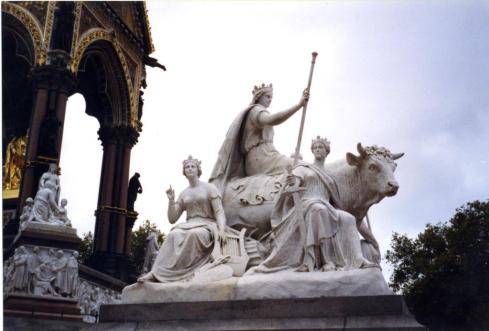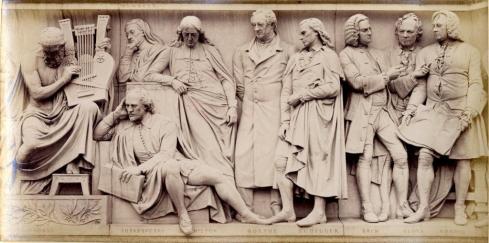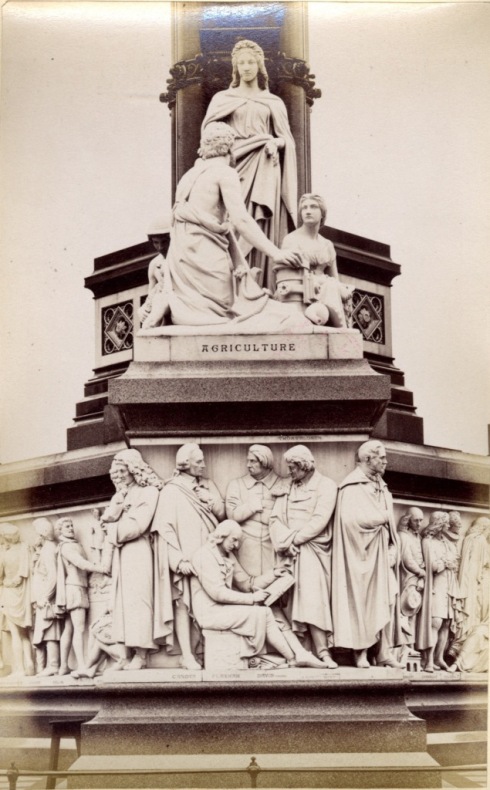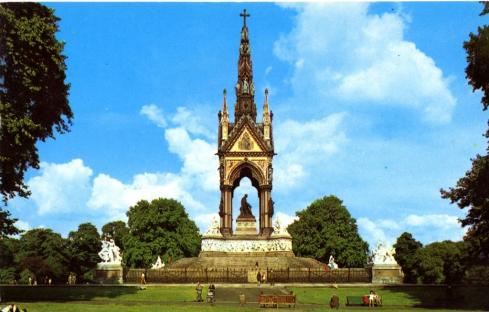Last week I noted that the climax of the Albert Memorial, the great statue of Albert took its place at the centre of a large group of other sculptures and figures. This week we’re going to have a closer look at those other statues. This picture shows the rising succession of steps and terraces
It is as though you are entering a sacred precinct in a temple complex. Perhaps you are. The Memorial is located at the apex of a series of great Victoria buildings among them the V&A, the Natural History Museum, the Imperial Institute (the brainchild of Albert’s son) and the Albert Hall which together formed the area in South Kensington called Albertopolis.
Albert is surrounded by guardians representing geography, art, science and religion. The outer ring joined by an ornate fence is the four continents, each represented by a series of figures and an animal.
Africa, behind it the dome of the Albert Hall. This is a fairly partial view of the African continent concentrating on north Africa, with an Egyptian figure mounted on a kneeling camel. (It was decided not to use a lion for Africa to avoid confusion with the “British” lion, although it might also have strained credulity to place a predatory animal among a group of people.) An engraving of the sculpture reveals a further detail.
The Sphinx – Egyptian imagery was extremely popular at the time.
America gets another quirky treatment.
The spirit of America rides the bison wearing a native American head dress. The woman standing is the United States. The seated man is an Aztec and there’s a Canadian woman on the other side. You can’t see the south American cowboy behind the bison. (The relevant engraving is no help in this regard).
Europe’s animal was the bull, possibly a reference to the story of Europa who was abducted by Zeus in the form of a white bull.
The bull is the only male in the group. The spirit of Europe rides the bull holding an orb and sceptre. Britain holds a trident symbolising ocean supremacy. Beside her, peaceful Germany, a home of learning, sits with a book. This time the engraving shows us the other side.
France has a sword for military prowess and Italy, with one finger raised as though shyly making a point, concentrates on the arts and music, with a palette and lyre. The 1998 photo shows that other side.
The last of the four groups was Asia, by John Foley who eventually sculpted Albert. This is the most striking of the four continents.
The woman on the kneeling elephant is unveiling herself not as an allusion to the sometimes explicit sculptures on Hindu temples but apparently because the Great Exhbition was a showcase for goods coming out of Asia. Beside her, a Chinese potter, an Indian warrior, a Persian poet and, unseen, an Arab merchant holding the Koran. You can glimpse him in the engraving.
After the continents, on the main plinth, the Parnassus frieze. 169 figures of individual poets, painters, musicians, architects, the contemporary idea of the finest or most significant in their respective fields. The carving was all done on the spot by two sculptors, John Birnie Philip and Henry Hugh Armstead.
Here Shakespeare lounges next to Homer with Chaucer looking on. At the other end Bach and Handel exchange musical ideas. (Between them Gluck looks overawed by the company).
A bunch of Italian old masters stand around. Raphael gets a throne, with Michaelangelo slumped against it deep in thought. (Not his only appearance on the frieze – he’s with the painters here and takes the central spot amongst the sculptors on another panel.)

The rule was that no living artists could be depicted, but the Queen made an exception for George Gilbert Scott himself. Modestly, he had himself placed discreetly just above the shoulder of Pugin. Wren is at the centre of this group of architects.
Above the frieze another set of group statues representing industry – agriculture, manufactures, commerce, engineering
Once again a set of figures engage in the work presided over by an idealised personage – a female muse. You can also see further eminent men on the corners of the frieze.

Manufactures – Turner sits at the centre of the group underneath.
Commerce, and below Engineering:
Sennacherib the Assyrian king and Cheops stand there discussing building work. Between them, looking a bit weary of the whole thing is Nitocris, a 6th dynasty Egyptian queen holding a model of a pyramid (she was credited with building the third pyramid).
Finally we reach the canopy itself where a set of plain bronze statues representing the sciences are gathered around Albert like a guard of honour
The lower group each on their own plinth:
Geometry, chemistry, geology and astronomy.
The upper group: philosophy, physiology, medicine and rhetoric.
I’ve rearranged the figures so they follow the spatial arrangement of the monument but if you look carefully you can see the figures are the work of two sculptors who took two corners each, our friends Philip and Armstead again.
The canopy is decorated by mosaics of four female figures- Sculptura, Poesis, Pictura and Architectura. I’ve picked the last one for a reason I’m sure you can guess.
Then there’s the spire, inhabited by the virtues, almost too high to make out in detail – Faith, Hope, Charity, Humility, Fortitude, Prudence, Justice and Temperance and above them two sets of angels before you get to the cross at the very top. This drawing shows the arrangement.
The whole thing is an anthology of Victorian iconography. Is it all a bit much for one man, no matter what he did, or how much he was missed? Well, you decide. The Memorial has proved to be a survivor.
This was it about 1970 with the ungilded Albert (and the statues on the spire, withthat bluish colour of old bronze.) And here they all are gilded again: Albert, the angels and the virtues:

Postscript
It was a purely factual post this week, and also a picture marathon. I remember many years ago watching an Open University documentary about the Albert Memorial which covered much the same ground. Do you remember how they used to broadcast in the early mornings and early hours of the morning in the dead hours before 24 hour television? Perhaps it was the oddness of the hour or the seemingly random nature of the subject matter but that documentary stuck in my mind. Hence the need, once I’d started, to lay out as much of the whole scheme as I could, for you. I’m taking a couple of team members out on Friday to take a look. It’s a reminder to me that it’s a privilege to work in an area with such a rich heritage.
And I’ve sneaked in the title of a Bill Nelson song.
The Albert Memorial: illustrated by 29 photographs (c1872)
The Albert Memorial, Hyde Park: its history and description by James Dafforne (Virtue & Co, 1878)
The National Memorial to His Royal Highness the Prince Consort (John Murray, 1879)
The two modern colour photographs were by Maureen G Stainton and are copyright by her.






















April 16th, 2015 at 7:54 am
Another thought provoking post Mr Walker… it was a very enjoyable diversion and of course informative as ever. The Albert Memorial is transformed.
October 21st, 2016 at 1:28 pm
Hi there,
Loving your blog. A question in relation to the Albert Memorial, do you know if there was an official book released at the time detailing the different sculptures and their meaning? I remember something on Paxman’s The Victorians where he read from a book at the memorial that discussed the images along with the ever prevalent “civilizing mission.”
October 21st, 2016 at 1:34 pm
I did use images from, and read, some contemporary books about the Memorial when I was writing the post but I don’t know if there was an official guide published at the time. There would probably have been quite a lot written about the memorial at the time. It was the winner of a competition and was a particularly complicated set of Victorian semiotics.
Dave
October 21st, 2016 at 1:47 pm
Just had a look at the Paxman episode and he does say “the guide book” while holding what looks like quite an old book. The section he reads on the African segment of the memorial is quite blunt, but in no way exceptional for the time
“The negro is representative of the uncivilised races of this continent. He is listening to the teachings of a female figure typifying European civilisatio in allusion to the efforts made by Europe to improve the conditions of those races.”
July 13th, 2018 at 11:07 am
Thanks for a great article. I had a question please – where did you source the images of the mosaic and the statues of the useful arts? I found two of the books you cited at the end, but couldn’t find the images in them.